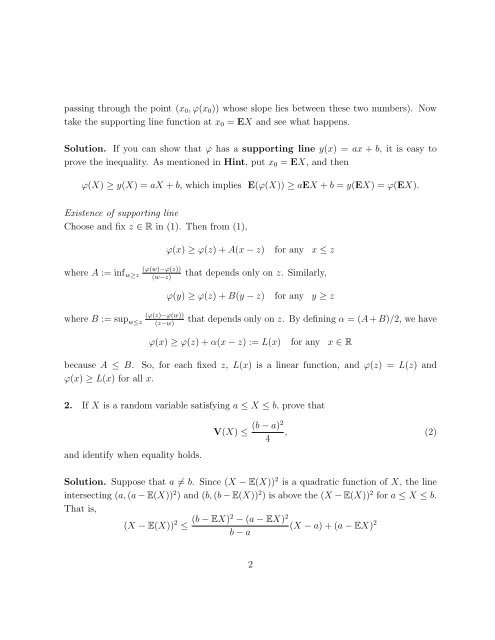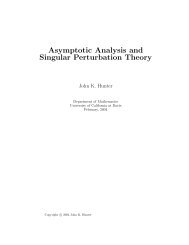Solutions to Homework Set No. 4 – Probability Theory (235A), Fall ...
Solutions to Homework Set No. 4 – Probability Theory (235A), Fall ...
Solutions to Homework Set No. 4 – Probability Theory (235A), Fall ...
You also want an ePaper? Increase the reach of your titles
YUMPU automatically turns print PDFs into web optimized ePapers that Google loves.
passing through the point (x0, ϕ(x0)) whose slope lies between these two numbers). <strong>No</strong>w<br />
take the supporting line function at x0 = EX and see what happens.<br />
Solution. If you can show that ϕ has a supporting line y(x) = ax + b, it is easy <strong>to</strong><br />
prove the inequality. As mentioned in Hint, put x0 = EX, and then<br />
ϕ(X) ≥ y(X) = aX + b, which implies E(ϕ(X)) ≥ aEX + b = y(EX) = ϕ(EX).<br />
Existence of supporting line<br />
Choose and fix z ∈ R in (1). Then from (1),<br />
where A := infw≥z (ϕ(w)−ϕ(z))<br />
(w−z)<br />
where B := sup w≤z<br />
(ϕ(z)−ϕ(w))<br />
(z−w)<br />
ϕ(x) ≥ ϕ(z) + A(x − z) for any x ≤ z<br />
that depends only on z. Similarly,<br />
ϕ(y) ≥ ϕ(z) + B(y − z) for any y ≥ z<br />
that depends only on z. By defining α = (A + B)/2, we have<br />
ϕ(x) ≥ ϕ(z) + α(x − z) := L(x) for any x ∈ R<br />
because A ≤ B. So, for each fixed z, L(x) is a linear function, and ϕ(z) = L(z) and<br />
ϕ(x) ≥ L(x) for all x.<br />
2. If X is a random variable satisfying a ≤ X ≤ b, prove that<br />
and identify when equality holds.<br />
V(X) ≤<br />
(b − a)2<br />
, (2)<br />
4<br />
Solution. Suppose that a = b. Since (X − E(X)) 2 is a quadratic function of X, the line<br />
intersecting (a, (a − E(X)) 2 ) and (b, (b − E(X)) 2 ) is above the (X − E(X)) 2 for a ≤ X ≤ b.<br />
That is,<br />
(X − E(X)) 2 ≤ (b − EX)2 − (a − EX) 2<br />
(X − a) + (a − EX)<br />
b − a<br />
2<br />
2
















